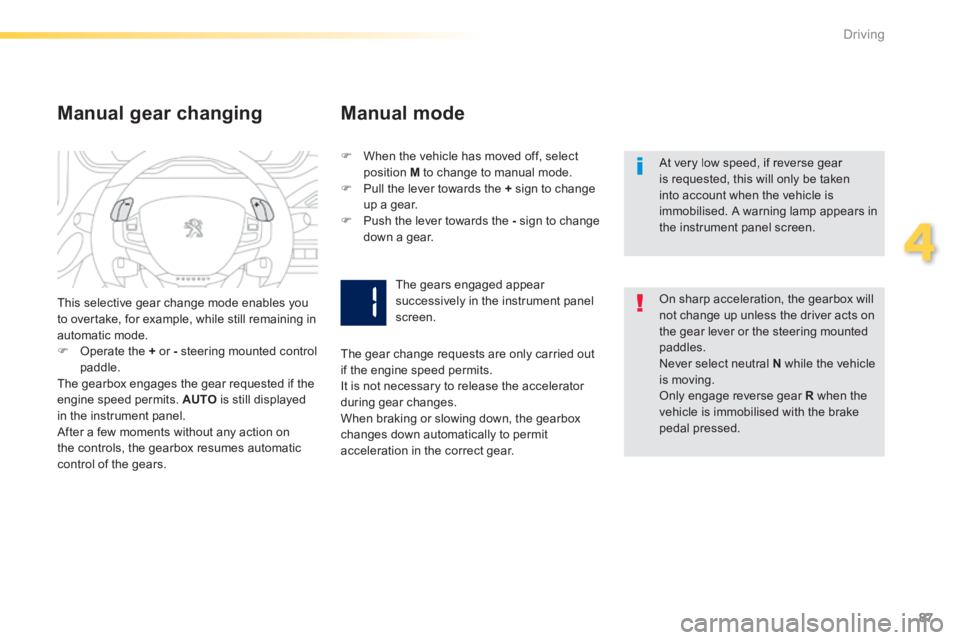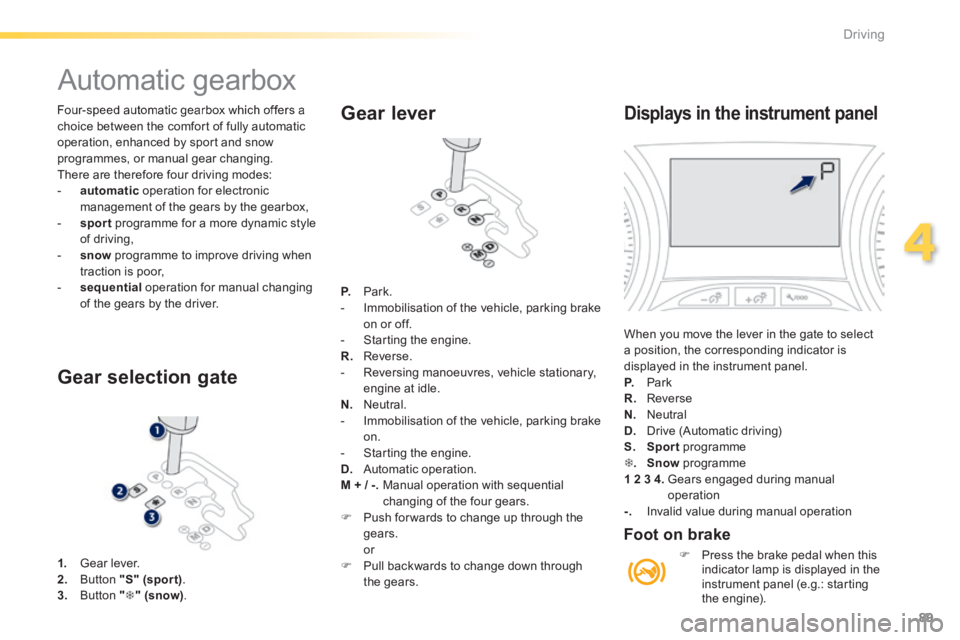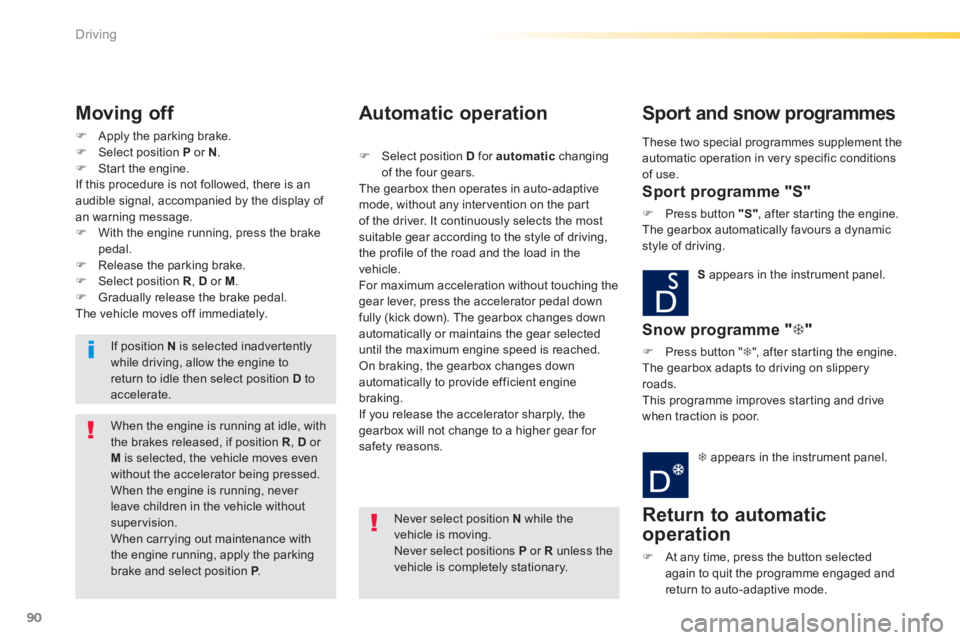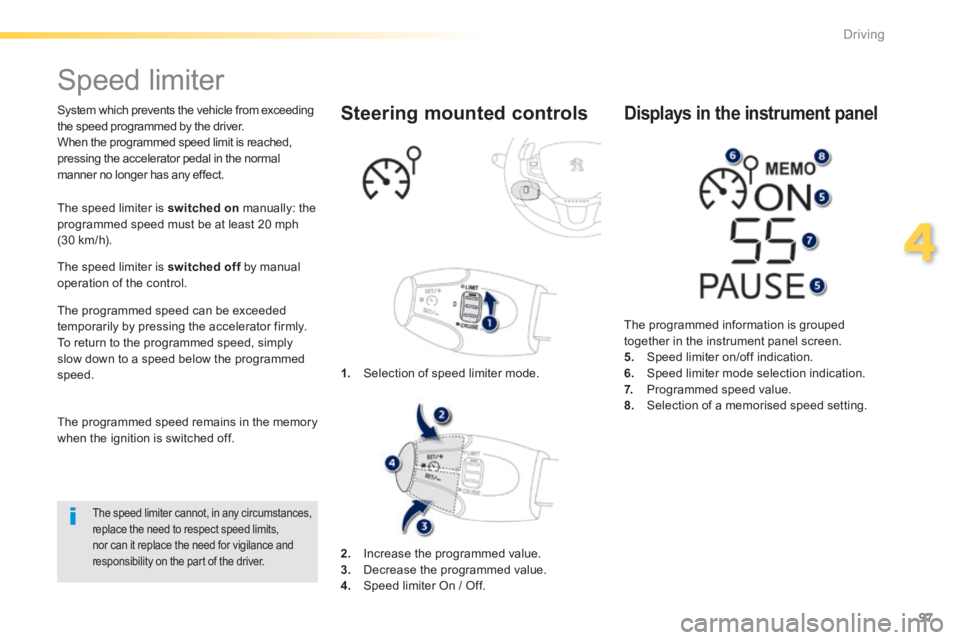2013.5 PEUGEOT 2008 display
[x] Cancel search: displayPage 89 of 336

87
4
Driving
At very low speed, if reverse gear is requested, this will only be taken into account when the vehicle is immobilised. A warning lamp appears in the instrument panel screen.
Manual gear changing Manual mode
On sharp acceleration, the gearbox will not change up unless the driver acts on the gear lever or the steering mounted paddles. Never select neutral N while the vehicle is moving. Only engage reverse gear R when the vehicle is immobilised with the brake pedal pressed.
This selective gear change mode enables you to overtake, for example, while still remaining in automatic mode. Operate the + or - steering mounted control paddle. The gearbox engages the gear requested if the engine speed permits. AUTO is still displayed in the instrument panel.
After a few moments without any action on the controls, the gearbox resumes automatic control of the gears.
When the vehicle has moved off, select position M to change to manual mode. Pull the lever towards the + sign to change up a gear. Push the lever towards the - sign to change
down a gear.
The gears engaged appear successively in the instrument panel screen.
The gear change requests are only carried out if the engine speed permits. It is not necessary to release the accelerator during gear changes. When braking or slowing down, the gearbox changes down automatically to permit acceleration in the correct gear.
Page 91 of 336

89
4
Driving
Four-speed automatic gearbox which offers a choice between the comfort of fully automatic operation, enhanced by sport and snow programmes, or manual gear changing. There are therefore four driving modes: - automatic operation for electronic management of the gears by the gearbox, - sport programme for a more dynamic style of driving, - snow programme to improve driving when traction is poor, - sequential operation for manual changing of the gears by the driver.
Automatic gearbox
1. Gear lever. 2. Button "S" (spor t) . 3. Button "" (snow).
Gear selection gate
Gear lever
P. Park. - Immobilisation of the vehicle, parking brake on or off. - Starting the engine. R. Reverse. - Reversing manoeuvres, vehicle stationary, engine at idle. N. Neutral. - Immobilisation of the vehicle, parking brake on. - Starting the engine. D. Automatic operation. M + / -. Manual operation with sequential changing of the four gears. Push for wards to change up through the gears. or Pull backwards to change down through the gears.
Displays in the instrument panel
When you move the lever in the gate to select a position, the corresponding indicator is displayed in the instrument panel. P. Park R. Reverse N. Neutral
D. Drive (Automatic driving) S. Sport programme . Snow programme 1 2 3 4. Gears engaged during manual operation -. Invalid value during manual operation
Foot on brake
Press the brake pedal when this indicator lamp is displayed in the instrument panel (e.g.: starting the engine).
Page 92 of 336

90
Driving
Apply the parking brake. Select position P or N . Start the engine. If this procedure is not followed, there is an audible signal, accompanied by the display of an warning message. With the engine running, press the brake pedal. Release the parking brake. Select position R , D or M . Gradually release the brake pedal. The vehicle moves off immediately.
Moving off
When the engine is running at idle, with the brakes released, if position R , D or M is selected, the vehicle moves even without the accelerator being pressed. When the engine is running, never leave children in the vehicle without supervision. When carrying out maintenance with the engine running, apply the parking brake and select position P . P . P
If position N is selected inadvertently while driving, allow the engine to return to idle then select position D to accelerate.
Never select position N while the vehicle is moving. Never select positions P or R unless the vehicle is completely stationary.
Automatic operation
Select position D for automatic changing of the four gears. The gearbox then operates in auto-adaptive mode, without any intervention on the part of the driver. It continuously selects the most
suitable gear according to the style of driving, the profile of the road and the load in the vehicle. For maximum acceleration without touching the gear lever, press the accelerator pedal down fully (kick down). The gearbox changes down automatically or maintains the gear selected until the maximum engine speed is reached. On braking, the gearbox changes down automatically to provide efficient engine braking. If you release the accelerator sharply, the gearbox will not change to a higher gear for safety reasons.
Sport and snow programmes
Sport programme "S"
Press button "S" , after starting the engine. The gearbox automatically favours a dynamic style of driving.
S appears in the instrument panel.
Snow programme " "
Press button " ", after starting the engine. The gearbox adapts to driving on slippery roads. This programme improves starting and drive when traction is poor.
appears in the instrument panel.
Return to automatic
operation
At any time, press the button selected again to quit the programme engaged and return to auto-adaptive mode.
These two special programmes supplement the automatic operation in very specific conditions of use.
Page 93 of 336

91
4
Driving
Manual operation
Select position M for sequential changing of the four gears. Push the lever towards the + sign to change up a gear. Pull the lever towards the - sign to change
down a gear. It is only possible to change from one gear to another if the vehicle speed and engine speed permit; otherwise, the gearbox will operate temporarily in automatic mode.
D disappears and the gears engaged appear in succession in the instrument panel.
Invalid value during manual operation
This symbol is displayed if a gear is not engaged correctly (selector between two positions).
Stopping the vehicle
Before switching off the engine, you can engage position P or N to place the gearbox in neutral. In both cases, apply the parking brake to immobilise the vehicle.
Operating fault
When the ignition is on, the lighting of this warning lamp, accompanied by an audible signal and a message in the multifunction screen, indicates a gearbox fault. In this case, the gearbox switches to back-up mode and is locked in 3rd gear. You may feel a substantial knock when changing from Pto R and from N to R . This will not cause any damage to the gearbox. Do not exceed 60 mph (100 km/h), local speed restrictions permitting. Contact a PEUGEOT dealer or a qualified workshop as soon as possible.
If the engine speed is too low or too high, the gear selected flashes for a few seconds, then the actual gear engaged is displayed. It is possible to change from position D(automatic) to position M (manual) at any time. When the vehicle is stationary or moving very slowly, the gearbox selects gear M1automatically. The sport and snow programmes do not
operate in manual mode.
There is a risk of damage to the gearbox: - if you press the accelerator and
brake pedals at the same time, - if you force the movement of the gear lever from the P position to another position when the battery is flat. To reduce fuel consumption when at a prolonged standstill with the engine running (traffic jam...), put the gear lever in the N position and apply the parking
brake.
If the lever is not in position P , when the P , when the Pdriver's door is opened or approximately 45 seconds after the ignition is switched off, a warning message appears in the screen. Return the lever to position P ; the message disappears.
Page 99 of 336

97
4
Driving
Speed limiter
System which prevents the vehicle from exceeding the speed programmed by the driver. When the programmed speed limit is reached, pressing the accelerator pedal in the normal manner no longer has any effect.
The speed limiter is switched on manually: the programmed speed must be at least 20 mph (30 km/h).
The speed limiter is switched off by manual switched off by manual switched offoperation of the control.
The programmed speed can be exceeded temporarily by pressing the accelerator firmly. To return to the programmed speed, simply slow down to a speed below the programmed speed.
The speed limiter cannot, in any circumstances, replace the need to respect speed limits, nor can it replace the need for vigilance and responsibility on the part of the driver.
1. Selection of speed limiter mode.
Steering mounted controls
The programmed information is grouped together in the instrument panel screen. 5. Speed limiter on/off indication. 6. Speed limiter mode selection indication. 7. Programmed speed value. 8. Selection of a memorised speed setting.
Displays in the instrument panel
The programmed speed remains in the memory when the ignition is switched off.
2. Increase the programmed value. 3. Decrease the programmed value. 4. Speed limiter On / Off.
Page 100 of 336

98
Driving
Turn thumb wheel 1 to the "LIMIT"position: the speed limiter mode is selected but is not switched on (PAUS E). You do not have to switch the speed limiter on in order to set the speed.
Programming
Pressing the accelerator pedal to exceed the programmed speed will not have any effect unless you press the pedal firmly past the point of resistance . The speed limiter is deactivated temporarily and the programmed speed, which is still displayed, flashes. Returning to the programmed speed, by means of intentional or unintentional deceleration of the vehicle, automatically cancels the flashing of the programmed speed.
Leaving limiter mode
Turn thumb wheel 1 to the "0" position: the speed limiter mode is deselected. The display returns to the distance recorder.
Operating fault
Set the speed value by pressing button 2 or 3 . You can then change the programmed speed using buttons 2 and 3 : - by + or - 1 mph (km/h) = short press, - by + or - 5 mph (km/h) = long press, - in steps of + or - 5 mph (km/h) = maintained press.
Exceeding the programmed speed
Switch the speed limiter back on by pressing button 4 again.
Switch the speed limiter on by pressing button 4 .
Switch the speed limiter off by pressing button 4 : the display confirms that it has been switched off (PAUSE).
In the event of a speed limiter fault, the speed is cleared resulting in flashing of the dashes. Have it checked by a PEUGEOT dealer or a qualified workshop.
On a steep descent or in the event of sharp acceleration, the speed limiter will not be able to prevent the vehicle from exceeding the programmed speed. To avoid any risk of jamming of the pedals: - ensure that the mat is positioned c o r r e c t l y, - do not fit one mat on top of another.
Page 101 of 336

99
4
Driving
Cruise control
System which automatically maintains the speed of the vehicle at the value programmed by the driver, without any action on the accelerator pedal.
The cruise control is switched off manually switched off manually switched offor by pressing the brake or clutch pedal or on triggering of the electronic stability system for safety reasons. It is possible to exceed the programmed speed temporarily by pressing the accelerator pedal. To return to the programmed speed, simply release the accelerator pedal. Switching off the ignition cancels any programmed speed value.
1. Selection of cruise control mode.
Steering mounted controls
The cruise control cannot, in any circumstances, replace the need to observe speed limits, nor can it replace the need for vigilance and responsibility on the part of the driver.
The programmed information is grouped together in the instrument panel screen. 5. Cruise control stopped/resumed indication. 6. Cruise control mode selection indication. 7. Programmed speed value. 8. Selecting a memorised speed setting.
Displays in the instrument panel
2. Increase the programmed value. 3. Decrease the programmed value. 4. Cruise control Off / Resume.
The cruise control is switched on manually: it requires a minimum vehicle speed of 25 mph (40 km/h), as well as the engagement of: - fourth gear on a manual gearbox, - second gear on an electronic or automatic gearbox, in manual sequential mode, - position A on an electronic gearbox or position D on an automatic gearbox.
Page 102 of 336

100
Driving
Turn thumb wheel 1 to the "CRUISE"position: the cruise control mode is selected but is not switched on (PAUS E).
Programming
You can then change the programmed speed using buttons 2 and 3 : - by + or - 1 mph (km/h) = short press, - by + or - 5 mph (km/h) = long press, - in steps of + or - 5 mph (km/h) = maintained press.
Intentional or unintentional exceeding of the programmed speed results in flashing of this speed in the screen. Return to the programmed speed, by means of intentional or unintentional deceleration of the vehicle, automatically cancels the flashing of the speed.
When the cruise control is switched on, be careful if you maintain the pressure on one of the programmed speed changing buttons: this may result in a
very rapid change in the speed of your vehicle. Do not use the cruise control on slippery roads or in heavy traffic. On a steep descent, the cruise control will not be able to prevent the vehicle from exceeding the programmed speed. To avoid any risk of jamming of the pedals: - ensure that the mat is positioned c o r r e c t l y, - never fit one mat on top of another.
Operating fault
Leaving cruise control mode
Turn thumb wheel 1 to the "0" position: the cruise control mode is deselected. The display returns to the distance recorder.
Exceeding the programmed speed
Set the programmed speed by accelerating to the required speed, then press button 2 or 3 .
Switch off the cruise control by pressing button 4 : the screen confirms that it has been switched off (PAUSE).
Switch the cruise control back on by pressing button 4 again.
In the event of a cruise control malfunction, the speed is cleared resulting in flashing of the dashes. Have it checked by a PEUGEOT dealer or a qualified workshop.